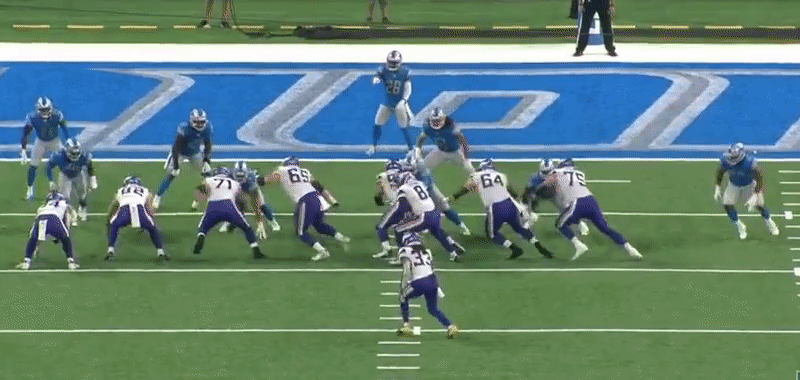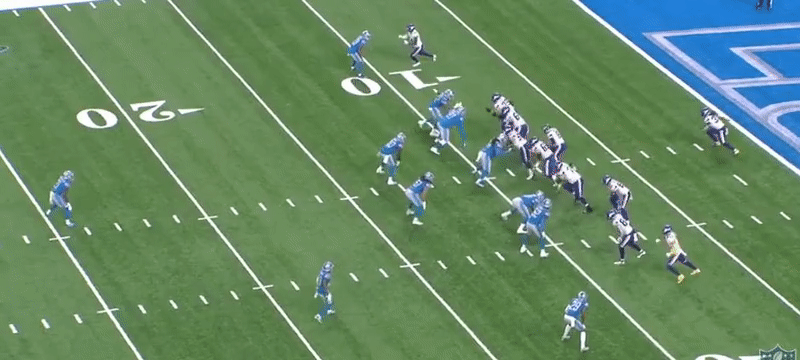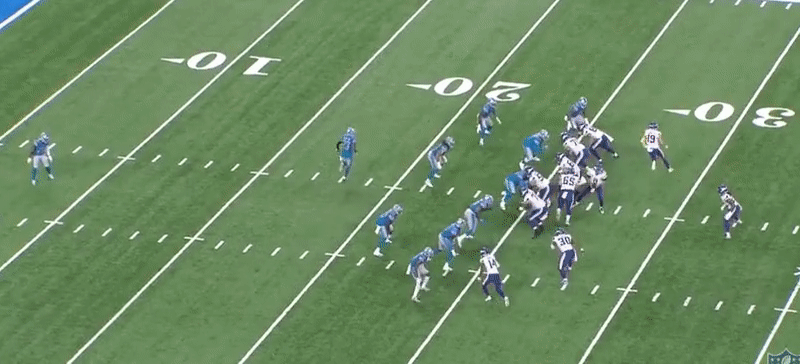Detroit Lions film review: Five observations vs. Vikings
 Justin Rogers
Justin Rogers
Allen Park — There was plenty good and a lot of bad from the Detroit Lions' 42-30 loss to the Minnesota Vikings on Sunday.
You can pretty much divide it up by sides of the ball. The majority of the positives came from Detroit's offensive performance, while the defense left many fans wanting to gouge their eyes out.
As is our tradition on Tuesdays, we spent the day watching the film to provide you with five observations from the tape.
Grounded and pounded
The Lions' run defense was so good to end last season, it almost felt like a given it would continue to be a strength in 2019. But though six games, they're one of the least effective units in the NFL.
Detroit has given up a minimum of 112 rushing yards each week, while opponents have averaged 4.5 yards per attempt in five of the six games.
Behind the physical backfield tandem of Dalvin Cook and Alexander Mattison, the Vikings chewed up 166 yards on the ground on Sunday. Cook, the league's leading rusher, did most of the damage, finishing with 142 yards on 25 carries.
On the surface, good runner, bad run defense, the story might seem pretty obvious. But let's dig into the details of what went wrong, focusing on Cook's seven carries that gained 8 or more yards.
On his second touch of the game, Cook took a single-back handoff heading right. The stretch run looked to be well-defended by the Lions with safety Tracy Walker filling the lane outside the offensive tackle Brian O'Neill and defensive tackle A'Shawn Robinson beating O'Neill's block, ready to provide support.
But Cook had other plans, spinning out of the grasp of Walker and taking the edge lost by linebacker Devon Kennard in the commotion. With a lot of open field, Cook gobbled up 15 yards before he was shoved out of bounds by Quandre Diggs.
In the second quarter, Cook went back to work with back-to-back big gains that set the Vikings up in the red zone. The first, a 10-yard gain, saw linebacker Jarrad Davis properly play his gap, funneling Cook toward Robinson, only to see the big man driven out of position by O'Neil.
More: Lions defensive lineman Damon 'Snacks' Harrison sees sharp dropoff in tackles
Rookie safety Will Harris was the next line of defense, and the man to make the stop, but he was 20 yards deep at the handoff because of the attention wide receiver Stefon Diggs merits in the deep part of the field.
On the next snap, Cook went left, to the strongside of the formation, where the Vikings had two tight ends off left tackle. Irv Smith Jr. was able to seal Lions linebacker Christian Jones inside, giving Cook the edge, while Kyle Rudolph shot into the second level to body Walker out of position, leading to a 14-yard gain.

The Vikings had a lot of success running left in this game, attacking Detroit's setup of Jones on the edge and Romeo Okwara playing in a 5-tech defensive alignment, between the guard and tackle.
This is where Detroit's injuries up front are showing. Okwara should be on the edge, in place of Jones, but is likely filling a spot that would be manned by either Da'Shawn Hand or Mike Daniels, who both remain sidelined. The Vikings exploited that look throughout the game. As good as Okwara is at using his length, he's not strong enough to anchor against the double-teams the Vikings were throwing at him.
More: Matt Patricia: Lions' Kerryon Johnson says he's fine, but awaits doctors' update
Cook picked up another eight yards with six minutes remaining in the first half, cutting back against the grain on a left-side run and hitting a gap vacated by Davis' over-pursuit.
Four plays later, Cook found the end zone for his first of two touchdowns, a 8-yard romp heading left. Predictably, the 274-pound Okwara was blown off the ball by a tackle-guard tandem block, opening the lane, while Smith Jr. handled Jones on the edge. Linebacker Jahlani Tavai had a shot to stop Cook before the goal line, but the back powered in through the contact initiated at the 2.

Cook was back at it in the third quarter, running behind fullback C.J. Ham out of I-formation. Tavai does a nice job taking on Ham in the hole and forcing Cook to re-direct to his left, but as Trey Flowers and Jones converge to fill that lane, they collided, once again allowing Cook to get the edge where he picked up 12 yards.
After a lull, Cook found daylight again with seven minutes remaining in the fourth quarter. On third-and-1, the Vikings ran a well-designed play which saw quarterback Kirk Cousins fake a handoff to a motion receiver before pitching left to Cook, one-on-one with Flowers on the perimeter. The back won the foot race to the edge, where Walker took out Flowers with friendly fire, leading to a game-long 23-yard gain.

While it's fair to question some of the personnel placement, I think the bigger issue, this week at least, was the personnel. The Lions badly need to get healthy at defense tackle. Additionally, tackling and fits continues to be a problem. Walker, in particular, missed two tackles that led to an additional 30 yards for Cook.
The big set up
Here's the thing about running the ball effectively, it sets up the play-action. And let me tell you, the Vikings love play-action. I didn't actually keep count, but according to Pro Football Focus, Cousins faked a handoff on 18 of his 34 drop backs. By percentage, it was the most by any quarterback in a game this season.
And, if we're being honest, the Vikings didn't even need to show the Lions they could run effectively, to bust out their play-action game. On the team's first offensive snap, Cousins faked to Cook and watched all three of Detroit's linebackers sell out for the run, before connecting with Diggs on a crossing pattern for 15 yards.

Those Vikings crossing patterns were nearly unstoppable. On the team's first touchdown drive, Cousins connected on two deep crossers out of play-action, beating man coverage both times. Smith Jr. got the best of cornerback Rashaan Melvin for a 28-yard pickup before Cousins found Adam Thielen with inside position on Darius Slay in the back of the end zone for a 25-yard scoring strike.

On the Vikings' 15-play, 97-yard touchdown drive in the second quarter, Cousins connected with Rudolph on a shallow cross twice for third-down conversions. The first, out of play-action, saw Melvin get caught looking into the backfield as Rudolph released off the line. The second, Cousins took advantage of a mismatch, with Jones covering the highly productive tight end in man-to-man coverage.

The final play-action crosser effectively ended the game. With a five-point lead and three minutes remaining, Cousins unloaded a deep ball to Diggs after a play fake. Cornerback Justin Coleman was in coverage with no help over the top. That's a mismatch for 95 percent of corners in the league and Diggs turned the opportunity into a 66-yard gain, making up for a touchdown pass he let slip through his fingers in a similar situation earlier in the fourth quarter.
Did blitzing help?
If you've missed it in some of our previous reporting, the Lions' pass rush has been anemic in 2019. The team is near the bottom of the league in both sacks and pressure, and according to an ESPN story that ran Tuesday afternoon, the Lions are the worst in the league in pass-rush win rate, by a wide margin.
Some, including myself, have suggested the team deviate from coach Matt Patricia's preference to rush only three or four and dial up a few more blitzes, looking for a spark. Against Minnesota, the team didn't exactly flip the script, but they definitely brought an extra defender on the rush more than they had in the previous five games.
Did it work?
Well, a little bit, particularly when the Lions sent Davis after Cousins. He forced a pair of throwaways on his own, although the Lions only rushed just four on own of those plays, dropping a defensive end into coverage. On another Davis blitz, Okwara got the pressure, leading to an incompletion.
Still, Cousins had a lot of success, even when the Lions brought extra pressure. He completed 7-10 for 157 yards and a touchdown.
Marvin's big day
In addition to the defense struggling to get to opposing quarterbacks, one of the biggest issues with Detroit's offense has been converting in the red zone. They entered Sunday having scored a touchdown on just half their trips inside the 20.
Against the Vikings, the Lions were a perfect 4-4, thanks to a huge day from receiver Marvin Jones.
Jones scored all four touchdowns, two on out routes and two running fades. Long part of his scouting report, Jones doesn't get a lot of separation against man coverage, but quarterback Matthew Stafford trusted the veteran receiver to make plays in tight spaces.
Jones exhibited outstanding body control on both fade balls, putting his body between the ball and the cornerback. With the out routes — long one of Jones' best sources of production — he did most of the work for his first score, taking a short throw and making a tackler miss for the 16-yard touchdown. Running the same route to the opposite side, he was able to pull in a Stafford throw that was behind him to cap the drive.
Jones actually dropped a touchdown prior to catching his third, just before halftime. This play was schemed up particularly well by offensive coordinator Darrell Bevell, who emptied out the backfield on the second-and-8 play from Minnesota's 10. Jones was the middle man in trips to Stafford's left, between Golladay on the outside and Amendola in the inner slot.
Jones and Amendola worked in combination to stress the Vikings' zone coverage. Amendola ran a corner pattern, drawing the safety to that side away from the middle of the field. Jones feigned a short sit-down route before stemming vertically into the space vacated by the safety. The pass was on point, but the ball was jarred free from Jones' grasp when he landed hard on his elbow.
Another bad call
Before anyone gets too worked up about this next point, just know, every NFL game has bad or blown calls, which hurt both teams. For example, on Stafford's 36-yard pass to Amendola in the first quarter, which pushed the quarterback over 40,000 passing yards for his career, the officials missed a blatant hold by left tackle Taylor Decker on Everson Griffen, preventing the edge defender from potentially getting to Stafford and altering the throw.
On the flip side, the Lions had a critical break go against them, also involving Griffen. In the fourth quarter, with the Lions trailing by four, the offense faced a brutal third-and-23 following a sack by, you guess it, Griffen.
Utilizing cadence on the third down, Stafford was able to draw Griffen offside before the snap, but as the ball was hiked, the officials whistled the play dead.
That should have never happened.
When a defensive player jumps early, the officials are required to immediately whistle it dead if they make contact with any offensive player, or the act of coming offside causes an offensive lineman to jump early. In all other cases, it's a judgment decision based on player safety, particularly if the defender has a clear path to the quarterback.
In this case, Griffen didn't make contact with any Lions players, the offensive line remained set through the snap and the defender attempted to get back onside, so he was moving away from the quarterback and not an immediate threat.
Instead of being blown dead, it should have been a free play.
That said, there's nothing guaranteeing the Lions accomplish anything with a free snap, but Stafford has long had a knack for turning those opportunities into big gains, heaving one up to Kenny Golladay or Marvin Jones in one-on-one coverage. In this case, the Vikings were in a deep, quarters coverage, so no one was seeing a one-on-one situation, but a chance something happens, including the potential to draw pass interference, is better than no chance at all.
Instead, the 5-yard infraction made it 3rd-and-18, the Lions picked up 16 on a pass to Amendola before failing to convert on fourth down.
jdrogers@detroitnews.com
Twitter: @Justin_Rogers